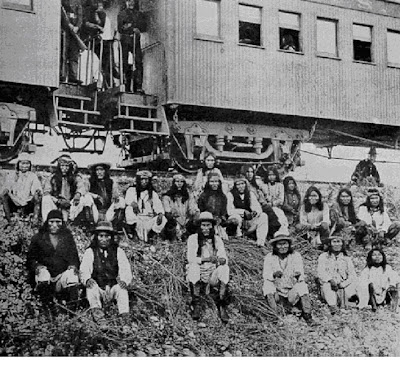The story I was told by my father, James Joseph Clancy Jr., was that his grandfather Michael joined the Army Calvary unit and was stationed at Jefferson Barracks. After duty in Texas St. Louis
I found a document titled “US Army register of enlistments”. Michael Clancy enlisted on June 17, 1885 in St. Louis , MO Oughterard , Ireland Tex
Original data: Register of Enlistments in the U.S. Army, 1798-1914; (National Archives Microfilm Publication M233, 81 rolls); Records of the Adjutant General’s Office, 1780’s-1917, Record Group 94; National Archives, Washington, D.C.
~~~~~~~~~~~~~~~~~~~~~~~~~~~~~~~~~~~~~~~~~~~~~~~~~~~~~
The 3d Cavalry Regiment dates back to 19 May 1846 , when it was constituted in the Regular Army as the Regiment of Mounted Riflemen at Jefferson Barracks in St. Louis , MO.
With the Apache uprising in the spring of 1882, the Regiment was ordered to Arizona Arizona
In 1885, the 3rd U.S. Cavalry was ordered back to Texas
There it was assigned to protect theTexas Arizona Fort Clark Brackettville , Texas San Antonio Mexico Fort Duncan Fort Clark Fort Clark
There it was assigned to protect the
Approximately one year after arriving from Ireland America Fort Clark , Texas
From 1878 to 1886, Geronimo and his small band of Apaches escaped from captivity several times. In September 1881, on the run from the American military, Geronimo led a raiding party of seventy Chiricahua, along with their families, across the Rio Grande Chihuahua Sonora
On May 17, 1885 , after escaping one more time, Geronimo led 134 warriors back to his old haunts in Mexico United States March 27, 1886 , General George Crook managed to arrange a two-day parley with Geronimo in Mexico
Soon after, Brigadier General Nelson A. Miles replaced General Crook. Miles was ordered to destroy or capture the hostiles "making active and prominent use of the regular troops." To enable Miles to carry out the new order the number of troops in the Department of Arizona was increased from 3,000 to 5,000. With 5,000 troops and 400 Apache scouts on his payroll, General Crook traveled 1,645 miles in five months in search of Geronimo.
Miles divided his command into "districts of observation," each manned by a highly mobile force. He employed an important innovation, the heliograph, a wireless telegraph based on mirrors reflecting the sun's rays, manned by Signal Corps detachments placed upon the highest peaks and prominent lookouts to discover any movements of Indians and to transmit messages. However, in four months of vigorous campaigning his 5,000 soldiers, a quarter of all American military forces, failed to kill or capture a single Apache raider.
Finally, on August 23, 1886, Lieutenant Charles B. Gatewood, leading 25 men and two Apache scouts through the Sierra Madre, located Geronimo and his band. The Apache leader agreed to talk to General Miles and joined Gatewood on the journey north. The formal surrender was made to General Miles at Skeleton Canyon Douglas , Arizona September 3, 1886 . This would be Geronimo's final surrender, after almost 30 years of fighting.
Geronimo had been at his peak strength when Miles began his campaign; his band contained thirty-five warriors and 109 women and children, including six half-grown boys. During his long wanderings his followers came and went as they pleased, and when he finally surrendered, his band had dwindled to twenty-four men and fourteen women and children, although only six men and four women and children had been killed. From the time he left San Carlos Agency until his surrender to Miles, his band is credited with killing 2 officers, 8 enlisted men, 12 Indian scouts, 75 American citizens and 100 Mexicans.
Geronimo and his followers began their years of captivity as prisoners in a strange land. The Indian Wars of the Southwest came to an end with their departure. On the morning of September 8, 1886 , General Miles sent the Apaches east on a train under heavy guard to Florida Fort Pickens Fort Marion Mount Vernon , Alabama Fort Sill , Oklahoma
In old age, Geronimo became, according to many tales, a "celebrity" of sorts. He appeared at the 1904 World’s Fair in St. Louis Fort Sill February 17, 1909 , after he lay in the middle of a road all night, drunk, in a freezing rain at the age of 85.
 |
C Troop 3rd Cavalry, Michael Clancy was in F Troop, 3rd Cavalry, |
S – site of Geronimo’s surrender at Skeleton Canyon Douglas , Arizona Sept 3, 1886 .
Sept 9, 1886, Geronimo and a small group of his warriors passed through El Paso on a Southern Pacific train on their way to Florida.
The Southern Pacific Sunset train route runs nearby Fort Clark (X) west of San Antonio. Michael Clancy may have seen Geronimo on this day enroute to San Antonio, perhaps even as the following photo was taken.
Band of Apache Indian prisoners at rest stop beside Southern Pacific Railway, near Nueces River , Texas September 10, 1886 . Among those on their way to exile in Florida Natchez
Though the Indian Wars of the Southwest were over, the Plains Indians continued their battles.
November 1889-1890- The Indians, anticipating their God's arrival with ghosts of their ancestors, enact a ghost dance to recall the buffalo and spirits of the deceased Indians.


